Country Name: Uzbekistan
Country Flag:

Uzbekistan has a rich history as a central hub on the Silk Road, linking China, the Middle East, and Europe. It was home to ancient cities such as Samarkand, Bukhara, and Khiva, which were centers of Islamic learning and trade. The region fell under Russian rule in the 19th century and later became part of the Soviet Union in 1924. Uzbekistan gained independence in 1991 following the collapse of the USSR and has since been transitioning from a Soviet-style planned economy to a more market-oriented system.
Tashkent
UTC +5
Position in the world: 56th largest country
Total Area: 447,400 square kilometers (172,700 sq mi)
Arable Land: ~10%
Uzbekistan has a continental desert climate with:
Hot summers (temperatures often exceed 40°C or 104°F)
Cold winters (temperatures can drop to -20°C or -4°F)
Low annual rainfall, leading to dependence on irrigation for agriculture
Uzbekistan is divided into 12 regions (viloyatlar), 1 autonomous republic (Karakalpakstan), and 1 independent city (Tashkent).
Key regions include:
Uzbekistan is resource-rich, particularly in:
Earthquakes: High risk, especially in the Tashkent region
Droughts: Frequent due to Uzbekistan’s arid climate
Water Shortages: The drying up of the Aral Sea has led to environmental and agricultural crises
Uzbekistan is landlocked and shares borders with:
Uzbekistan is one of only two double landlocked countries in the world (along with Liechtenstein). It has no direct maritime access but is involved in Caspian Sea trade via Kazakhstan and Turkmenistan.
Uzbekistan is strategically positioned in Central Asia and plays a balancing role between major powers.
Russia – Military and economic cooperation via the CSTO and EAEU discussions
China – Infrastructure and trade ties under the Belt and Road Initiative (BRI)
Turkey – Growing cultural and economic ties
United States & EU – Seeking investment and economic modernization
Middle East (UAE, Saudi Arabia, Iran) – Expanding energy and trade cooperation
Government Type: Presidential Republic
President: Shavkat Mirziyoyev
Top 3 Political Parties & Ideology:
Uzbekistan Liberal Democratic Party (O‘zLiDeP) – Pro-government, center-right
Democratic Party of Uzbekistan (Milliy Tiklanish) – Nationalist, conservative
Social Democratic Party (Adolat) – Center-left, social democracy
Presidential Term: 7 years (renewable)
Next Elections: 2026 (presidential), 2025 (parliamentary)
Regional Leadership: Uzbekistan promotes Central Asian integration.
Multi-Vector Diplomacy: Balancing ties with Russia, China, and the West.
Security Cooperation: Active in anti-terrorism efforts, particularly regarding Afghanistan.
Position in world: 78th largest economy
GDP: $86 billion
GDP per capita: $2,400
Currency: Uzbekistani so‘m (UZS)
Dominant Economic Sector: Oil & Gas
Market Type: Frontier Market (with a mixed economy in transition towards a market economy)
Social Landscape
Population: ~36 million (2024 est.)
Class Distribution:
Upper Class: ~7%
Middle Class: ~50%
Lower Class: ~43%
Gini Coefficient: ~36 (moderate inequality)
Languages
Official Language: Uzbek
Widely Spoken: Russian (especially in urban areas and business)
Other Languages: Tajik, Kazakh, Karakalpak, Korean
Religion
Dominant Religion: Islam (Sunni, predominantly Hanafi school)
Other Religions: Eastern Orthodox Christianity, Judaism, Buddhism